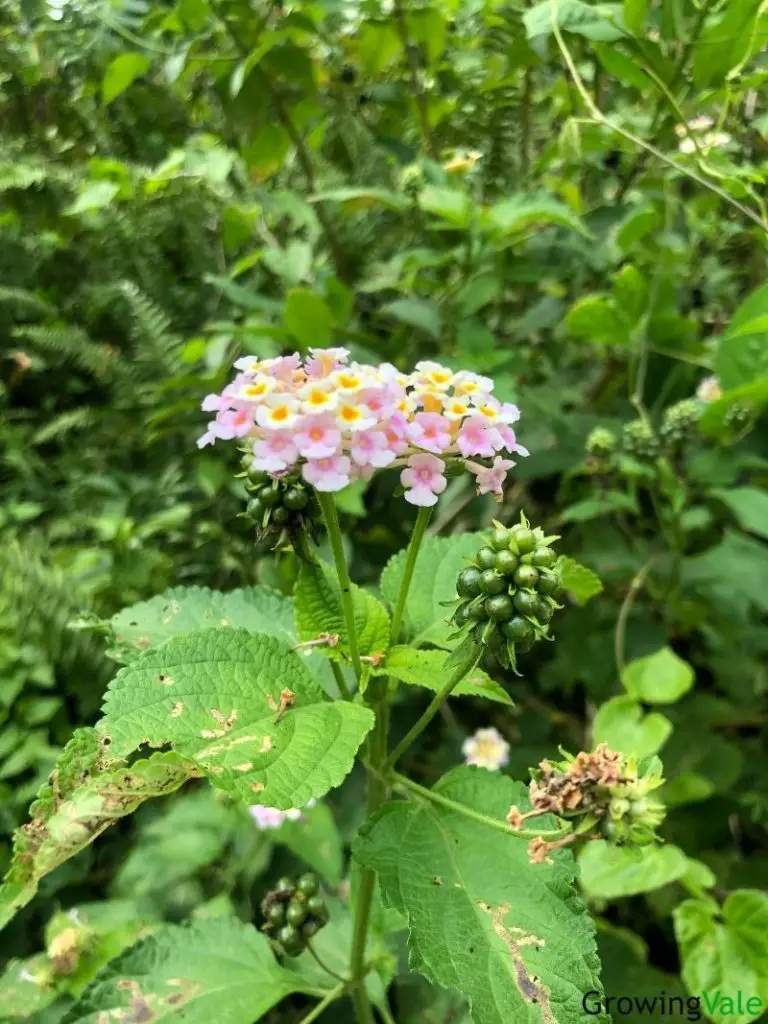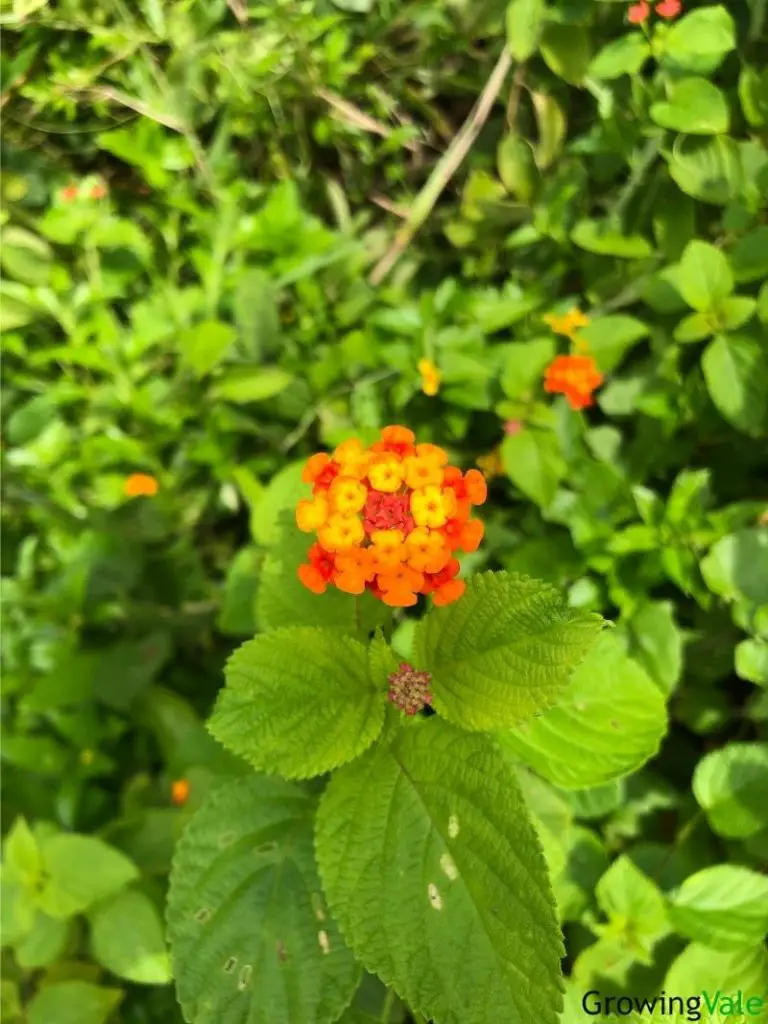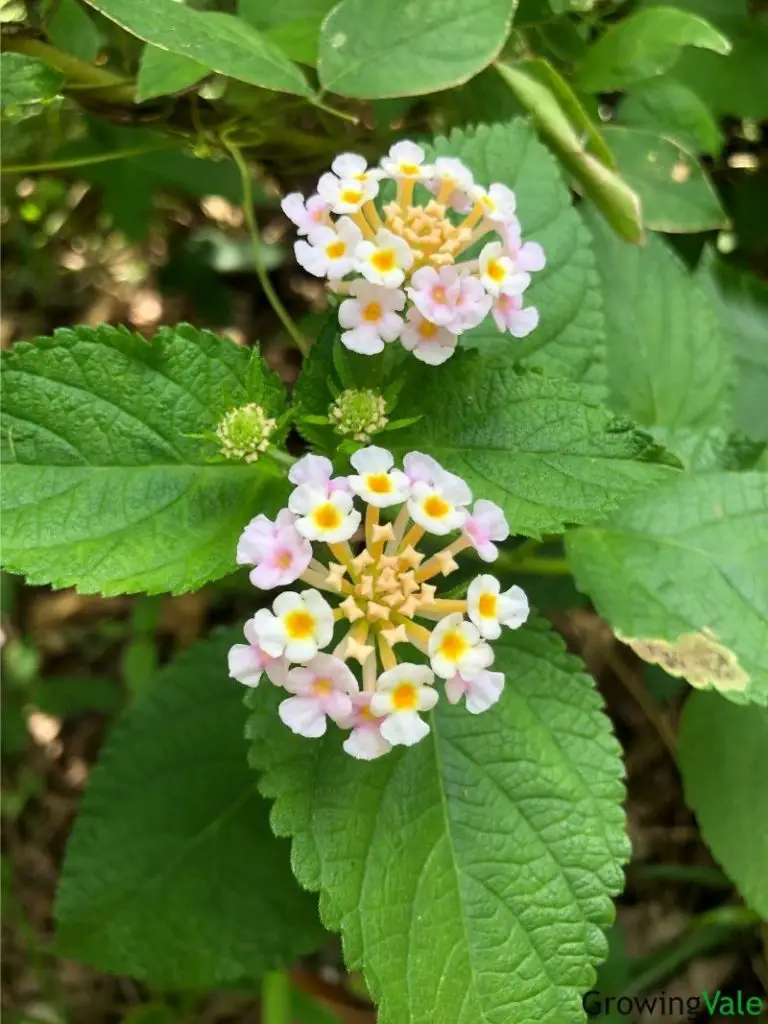Lantanas are a group of over 150 flowering plants that belong to the genus Lantana, and the verbena family, Verbenaceae. They are evergreen shrubs that are normally perennials, but they can be grown as annuals in colder climates. These plants are well-loved garden ornamentals with the most popular variety being L. camara and its cultivars!
Lantana flowers are popular for a range of garden styles including cottage-style and informal gardens. They are well-suited for container planting and are useful for brightening up patios and city gardens! Lantanas are extremely versatile and their brightly-colored blooms look fantastic in tropical gardens too!
History
These shrubs are native to parts of tropical Africa and America and gained popularity in Europe in the 18th century as greenhouse plants. Since then they have been cultivated extensively, giving us the hundreds of varieties we have today!
Lantanas can be loosely categorized into two forms, compact and trailing. Compact forms are ideal for container planting or confined spaces. Trailing types on the other hand can cover an area as large as 5 feet, so are better suited for beds and borders.
They have bold, long-lasting, tubular flowers that grow in dense clusters to form a dome shape or umbel. Blooms can be made up of one, two, or three colors, in shades of white, pink, red, purple, yellow, and orange! Multi-colored lantanas have flowers that change with maturity, so newer central flowers will have a different color than older, outer blooms.
Plant Facts
| Scientific name | Lantana spp. |
| Common names | Lantana, Trailing Lantana, Common Lantana, Yellow Sage, Shrub Verbena, Wild Verbena |
| Genus | Lantana |
| Family | Verbenaceae |
| Height | 1 ft. 0 in. – 6 ft. 0 in. |
| Width | 1 ft. 0 in. – 5 ft. 0 in. |
| USDA Plant Hardiness Zone | 8 – 11 (depending on variety) |
| Origin | Tropical Africa and America |
| Flower colors | White, Pink, Red, Orange, Yellow, Purple, Multi-colored |
| Blooming season | Spring to Fall (depending on variety) |
| Plant/Flower special features | Umbels of brightly colored flowers |
How to Plant Lantanas
Lantanas should be planted in spring once soil temperatures reach at least 60°F. Make sure to check the height and spread of varieties before purchasing to ensure they will be suitable for the space they will be planted in.

Grow Lantana Bushes in Beds
To grow lantanas in beds, first, remove any weeds and loosen the soil, then dig a hole that is as wide and deep as the root ball. Carefully tip the plant out of its container and tease the roots gently if they are clumped together. Place the roots inside the hole so they are just buried below the surface then fill it in with soil and firmly pat-down. Water well to settle the soil and make sure the plants are spaced a minimum of 12 inches apart.
Growing Lantana Bushes in Containers
To grow these plants successfully in containers, choose a good-sized pot with several drainage holes. If plants will be brought indoors over winter, there’s no need to worry about containers that will be fragile in winter conditions. Fill up the pot with a well-draining, soil-based compost and follow the above guidelines for planting. Make sure to leave a 1-inch gap between the top of the soil and the container edge to allow for water to soak in.
If there will be more than one plant per pot, they may need to be spaced closer together for a more attractive display. When pairing lantanas with other container plants, ensure that the needs of both plants are similar.
How to Propagate Lantanas
Lantana flowers can be propagated from seeds or cuttings. Grow them from cuttings to produce identical plants, as those grown from seed often don’t grow true to the parent plant. Some more recent cultivars have been bred to never set seed, so propagate these types from cuttings.
Propagate Lantanas From Seeds
To propagate lantana bushes from seeds, wait until around 3-4 months before the last spring frost to sow seeds indoors. It is recommended to soak the seeds for at least 24 hours before sowing. Sow them in individual modules filled with a moist, sterile seed mix. Press each seed into the soil and sow them at one per module.
Lightly water the compost after sowing and place the modules in a closed lid propagator or cover them with a plastic bag, removing the bag twice a week for 10 minutes for ventilation. Maintain a temperature of 70-75°F and keep the soil moist. Expect seedlings to emerge in 42-56 days, once this happens remove them from the propagator or plastic cover.
Keep the soil moist and once the first sets of true leaves have emerged prick out the seeds and plant them in 3.5-inch pots. Harden them off before planting them outside.
Propagate Lantanas From Cuttings
Take 2-4-inch long softwood cuttings in spring or summer, cutting just below a node using a sharp, clean, knife. Remove the lower leaves and pinch off the soft tip. Dip the end in liquid or powder rooting hormone and place in pre-made holes in a pot/tray filled with sterile seed mix.
Place the cuttings in a closed propagator that has a bottom temperature of 64-75°F or cover them with a plastic bag and place them in a warm area with indirect light. Keep the soil moist, and twice a week ventilate the cuttings for 10 minutes by removing the plastic bag. Expect them to develop roots within 2-4 weeks. Harden them off before potting them up individually and planting them out once soil temperatures reach at least 60°F.
Harden them off by slowly increasing the ventilation of the propagator or plastic bag.

Care and Maintenance
Here are some general tips on how to care for your lantana shrubs:
Soil
Lantana flowers should be grown in fertile, well-drained soils, but are tolerant of poor soils. L. montevidensis does best in slightly sandy, dry soils. Slightly acidic soil is a good start.
Water
Newly planted lantanas will need the soil to be kept moist during their first few weeks of establishment.
During the growing season, water them freely; however, take care not to overwater them. A good measure is to water them when the top 1-2 inches of soil is dry. During winter, keep the soil just moist.
Container-grown lantana plants will need more frequent watering as often as once a day, assuming the pot has sufficient drainage. If overwintering container plants indoors, drastically reduce watering until they are brought back outdoors.
Make sure to water the soil around the base of the plant and avoid getting any foliage or flowers wet to avoid powdery mildew.
Fertilizer
During the time of planting, add a general-purpose, balanced N-P-K fertilizer into the soil or potting mix following the manufacturer’s recommendations. After this, lantanas generally do not require feeding, and over-feeding may decrease blooms.
However, they can be fed once a month with a balanced N-PK fertilizer at half the amount recommended on the package instructions if desired.
Sunlight
These plants are tolerant of some light shade, but perform best in full sun conditions with at least 8 hours of direct sunlight a day.

Temperature and Humidity
Lantana flowers are extremely heat-tolerant and are well-suited to high humidity environments. They can be grown as perennials in warmer climates but double-check their hardiness when purchasing as some varieties are less hardy than others. L. camara for example is suited to USDA zones 10-11 (its roots are hardy down to zone 9) whereas L. montevidensis is winter hardy in zones 8-10.
In colder climates, they are often grown as bedding annuals during the summer or grown in containers and overwintered indoors.
Pest and diseases
Lantana plants are low maintenance and generally trouble-free, but they are susceptible to powdery mildew and whitefly infestations.
Less commonly, they can be affected by lantana lace flies, suffer caterpillar damage, and be infested with mites. They may also get root rot in poorly drained soils.
Pruning
Deadheading lantana flowers will encourage repeat blooming. Give the plants regular, light pruning if desired to give them a nice shape and bushy appearance. Plants that have begun to spread too much can be cut back by up to a third of their height and width.
Lantana shrubs being grown as perennials should be heavily pruned in March to prevent plants from becoming too “woody”. Cut them back to around 6-12 inches from the ground. Heavily pruning perennial plants in the fall is not recommended as this may reduce their hardiness.
Overwintering
When growing lantanas in their preferred climate, overwintering is not necessary. However, in the case of L. camara which has roots that are hardy down to zone 9, the plant will die back over winter in zone 9 but if well-mulched, should begin growing again the following spring.
Container-grown lantana plants can easily be overwintered indoors and put out the following spring. However, due to the limited light availability during the winter months, the best way to care for lantanas over winter is to let the plants go dormant. To do this, place the container in a place with minimal light, at a temperature of 50-60°F, and water sparingly.
Once temperatures warm up, move the plant outdoors and it will start growing again.
Toxicity
Handle lantanas with care as their foliage may cause irritation. Their berries, when unripe, are mildly toxic so keep a close eye on children and pets. Symptoms of poisoning include dilated pupils, labored respiration, diarrhea, and vomiting.
Uses of Lantana Flower
Lantanas are extremely versatile plants and have many uses other than as garden ornamentals. Although their unripe berries are toxic, their ripe, deep purple berries are safe to consume and can be made into jam! Remember to always thoroughly research and consult with a medical professional before attempting to consume any garden plant.
They are used for traditional medicine in their native range. In Uganda for example, they are used to treat a range of infections including respiratory tract infections. Their other uses include firewood and for making furniture.
Common Varieties and Cultivars
Here are a few of the most popular lantana varieties:
- (L. camara) Common Lantana – commonly called Yellow Sage, this lantana plant is one of the most well-known and grows between 3 and 4 feet tall. It has clusters of flowers that begin as yellow before maturing to red.
- (L. camara) Feston Rose – Feston Rose reaches 40 inches tall and produces umbels of flowers that open as creamy yellow before maturing to soft pink.
- (L. montevidensis) Trailing Lantana – this variety grows up to 18 inches high with a maximum spread of 5 feet. It produces umbels of lilac-pink flowers with yellow throats.
- (L. montevidensis) White Lightnin’ – White Lightnin’ will grow as tall as 12 inches and may cover an area as large as 6 feet. It produces clusters of pure white flowers with bright yellow throats.
Conclusion
Lantanas are flowering, evergreen perennials that belong to the Lantana genus. There are over 150 species of lantana that can be classified as either compact or trailing. Compact types are great as container plants whereas trailing types are perfect for beds and borders!
They are native to tropical parts of Africa and America and normally grow in a hot, humid climate. Because of this, lantanas are usually grown as bedding annuals in other parts of the world or in containers to be overwintered indoors.
They have many uses including in traditional medicine, firewood, and for making furniture! However, lantanas are hugely popular and versatile garden ornamentals that suit a range of styles from cottage-style to tropical gardens!

